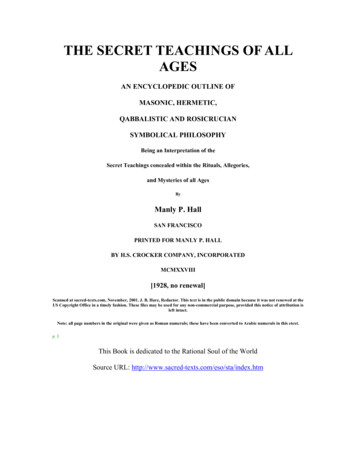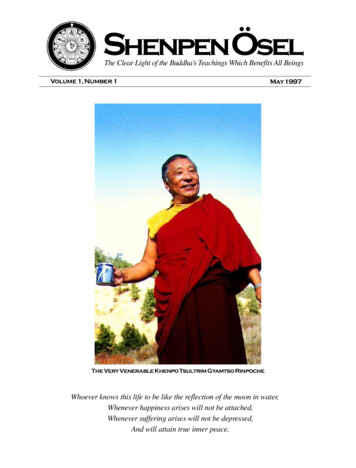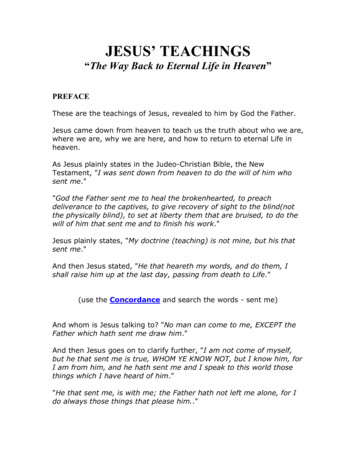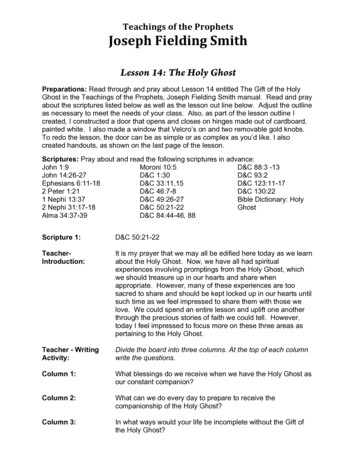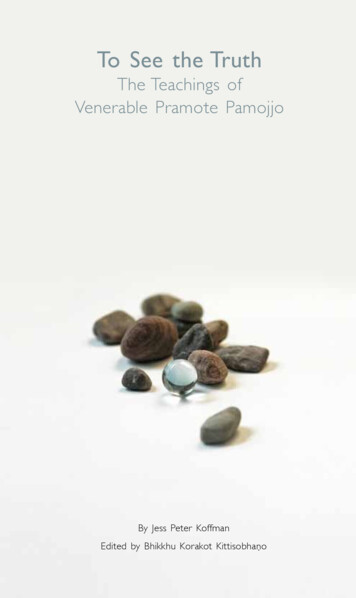
Transcription
To See the TruthThe Teachings ofVenerable Pramote PamojjoBy Jess Peter KoffmanEdited by Bhikkhu Korakot Kittisobhan·o
To See the TruthThe Teachings ofVenerable Pramote PamojjoBy Jess Peter KoffmanEdited by Bhikkhu Korakot Kittisobhan·o
First Edition: May 2012, 5000 copiesCopyright 2012 by Suan SantidhamCompiled and Translated by: Jess Peter KoffmanEdited by: Bhikkhu Korakot KittisobhaṇoProofreaders: Vipasie Smitthipong and Ruth FriedmanLayout & cover design: Nabwong ChuaychuwongCo-ordinator: Hataitip DevakulPrinted in ThailandThis edition is produced for free distribution with support from layfollowers of Venerable Pramote PamojjoInquiries may be addressed to:Suan Santidham332/1 Moo 6, Baan Kongdara, NongkhamSriracha, Chonburi 20110, ThailandInformation about the translator can be obtained at www.jesskoffman.com. He can be contacted at jesskoffman@hotmail.com.Venerable Pramote Pamojjo and Suan Santidham give the gift ofDhamma for free. This book is available at Suan Santidham inSriracha, Thailand, and the eBook/pdf file is available for freedownload at www.wimutti.net.
ContentsForwardiGlossaryviiWatching the Mind 1011Two Kinds of Samˉadhi (Concentration)23Just Know51My Journey to Correct Meditation77To See the Truth117About Venerable Pamojjo152
To See the Truth
The Teachings of Venerable Pramote PamojjoForwardIt is an honour only surpassed by my opportunities to learn with him in person that I bringyou this compilation of Venerable Father PramotePamojjo’s teachings on meditation and Dhammapractice. The principles that Venerable Father(“Luang Por”) Pramote teaches somehow feel newand unprecedented, and yet when one reads theBuddha’s teachings on mindfulness and the Abhidhamma (higher teachings), it seems Luang Poris completely consistent with scripture. The Buddha, in his enlightenment, brought the teachingsof how to end suffering to this world. Luang PorPramote is propelling his students to see that thispath to spiritual enlightenment (nibbāna) is available for everyone who wishes to walk it. He hassparked a movement of Dhamma practice amongthe younger and more intellectual Thai Buddhists,and there is a sense of renewed faith and diligencein meditation practice among them. Thousandsof practitioners, including myself, are experiencing great benefits along the way, as mental suffering lessens in severity and duration as a result ofi
To See the Truthpracticing according to the teachings Luang PorPramote shares in his talks.Luang Por’s Dhamma talks are given in the Thailanguage and have been translated into English inthis compilation from their audio recordings. Luang Por travels across Thailand to teach the mostprofound Dhamma in easily comprehendible ways,suitable for all ages and all levels of practice. Hespeaks jovially, uses modern colloquial Thai, andthe topics he relates are helpful for everyonefrom complete beginners to the most advanced ofDhamma practitioners. He resides at his centrefor the study of Dhamma called Suan Santidham,“The Garden of The Peaceful Dhamma,” in a secluded and forested area of Sriracha, Chonburi,Thailand. At least two mornings per week, hegives Dhamma talks at this location to audiencesof one or two hundred practitioners of all levels ofunderstanding and from all around the country.My intent in this translation and compilationis to expose the teachings of Luang Por to a widerrange of people who may be interested in practicingthe Dhamma, and who are denied the privilegeof directly receiving his teachings offered in theThai language. This is an aid for meditators whoare willing to open their minds to the essentialprinciples of meditation and who are willing toii
The Teachings of Venerable Pramote Pamojjopractice diligently according to these principles toattain insight and liberating wisdom.Luang Por was an extremely avid meditation andmindfulness practitioner for over 40 years beforehe became a monk. He studied in the Thai forest monk tradition where most of the details ofmeditative development were kept in small circlesof monks. Luang Por Pramote, however, practicedas a non-monk for a long time before ordainingand believes that the newer generations are able tounderstand and practice meditation in the correctway to attain insight wisdom and stages of enlightenment without the need for monkhood. Hehas a deep understanding of the trials, errors andtribulations that keen meditators encounter in pursuit of the Dhamma. His insights and guidancehave been invaluable to a great many in Thailand;indeed, Luang Por has an unprecedented amountof followers who have awakened to different levelsof wisdom into the Truth.This compilation is not intended as a scholarlyendeavor; therefore, many Buddhist terms havebeen removed or altered with permission of SuanSantidham for ease of understanding by Buddhistsand non-Buddhists alike. The talks in this bookare not translated in their entirety. Teachingsthat are aimed at specifically a Thai audience andiii
To See the Truthcomprising of Thai cultural references have beenremoved. Some portions that do not pertain tothe main topic of the talk have also been removed.A few portions have been expanded upon (an extrasentence at most) where knowledge of Buddhistprinciples was presupposed. The language has alsobeen kept casual and informal as to keep to the feelof the Dhamma talks as best as possible. Luang Porspeaks very much like a warm and helpful friend,looking to improve or correct our understandingof the principles of the practice. He lectures dayin and day out on the principles of meditation andaids countless practitioners with personal attentionso they can develop further.I selected talks covering subject matter that Luang Por Pramote tends to emphasize most. EachDhamma talk presented in this compilation is followed with a series of short conversations withLuang Por. The short conversations were chosenaccording to their relevance to each topic. Someof which occurred on the dates of the translatedtalks and some were chosen from entirely otherdates as referenced. After each of his DhammaTalks, Luang Por Pramote allows practitioners toupdate him on their progress (which has becomeknown as “submitting their homework”) and askfor advice pertaining to their meditative development. Attendees often listen in as a support to theiriv
The Teachings of Venerable Pramote Pamojjoown practice. His format is here emulated, thoughpriority was loosely given to subject matter ratherthan the date and location of the conversation.His ability to relay the Buddha’s ancient teachings in such a fresh and modern way is clearly seenas a result of the completeness and profundity ofhis own understanding of the practice he teaches. However, he reminds appreciative studentsthat it is the Buddha who brought these teachingsto humankind, and certainly not himself. WhenLuang Por Pramote speaks, he has a way of sayingexactly what a given Dhamma practitioner needs tohear at the time it needs to be heard. Somehowthe teaching appropriate for each student eases itsway into his talks at the appropriate moment tohelp reveal more Truth and bring a deeper understanding.It is my hope that the power and timeliness ofthe teachings are not completely lost in translation and the reader is able to develop his or herunderstanding of the Dhamma and hence, cometo see the Truth.Jess Peter KoffmanSeptember 16, 2011.v
To See the Truth
The Teachings of Venerable Pramote PamojjoGlossaryDefilements – Usually spoken of under the subheadings of greed (desire), aversion (fear, anger,sadness, etc.) and delusion (ignorance of Truth;lack of wisdom), these are what taint or cloud themind incessantly, making it impure and unable tosee things as they are.Dhamma Practice – Both formal meditation andpractice in daily life in conjunction with Buddhistteachings in order to gain wisdom, see things asthey are and thus liberate from suffering.Fabrication – Sankhāra or mental formations. Inthis translation, fabrication is usually referring tounnoticed defilements coming in and creating ourdeluded sense of who we are and our make-believesituation. In some cases, the meaning of fabricationis merely illusions created by thought.Khandhas or Aggregates – These are the fivegroupings that comprise body and mind: form,feelings, memory, mental formations and consciousness. Regular, non-enlightened human beings arevii
To See the Truthdeluded in believing that they are these khandhasand have not realized the truth that there is no self.Mind – Mind is used in two main ways, to bedeciphered by context. 1) The most common usageis in the term “body and mind” or in phrases suchas “we must be minful of this body and this mind”,where body represents the first khandha (“rūpa”)and mind is an inclusive term for the last four ofthe five khandhas (“nāma”) in which all mentalphenomena can be grouped: feelings, memory,mental formations and (bare) consciousness.2) The second most common usage is the mind asthat which watches, is aware or knows. It is aneasy way to denote the fifth khandha, consciousness,as to not make it seem too abstract of a concept(and to avoid confusion between it and the pureconsciousness that is spoken of in new-age spiritualbooks). The mind that Luang Por Pramotespeaks of here is the bare consciousness that is arudimentary awareness allowing the experience of aphenomenon to occur. It arises and falls along witheach phenomenon. As an example of this usage,Luang Por often says, “The body stands, walks,sits and lies down, and the mind is the watcher.”Mindfulness – Awareness of physical or mentalphenomena. More specifically, awareness of whatthe body is doing in real time, or recognizingviii
what mental phenomena or behaviours have justarisen. Genuine mindfulness arises automaticallyas a result of the practitioner’s ability to be awareof the body and to recognize mental phenomenawhen they arise.Nibbˉana – Nirvana, Enlightenment, the end ofsuffering, the eradication of the defilements.Phenomena – Mental and physical phenomena. Physical phenomena include bodily movements, breathing, bodily positions (standing,sitting, lying down) and the like. Mental phenomena are primarily mental states, such as thatof thinking, restlessness, or curiousity, emotions,and feelings, but are primarily called phenomenain this book as in their true nature, such stateslast only momentarily.Wisdom – True wisdom in Buddhism is not intellectual knowledge, but comes from seeing the truthof how things really are through direct experience. Here it implies seeing at least one of theThree Characteristics of body and mind: thingsare impermanent (always changing), unsatisfactory(they don’t persist), and they are non-self (not undercontrol). This will be explained in detail in thetext.
To See the Truth
The Teachings of Venerable Pramote PamojjoWatching the Mind 101Suan Santidham, April 03, 2009Welcome everyone. It is nice to see a newgeneration of people interested in the Dhamma, theBuddha’s teachings on the true nature of things. Ifind that young and inexperienced people are muchbetter students of the Dhamma. They are mucheasier to teach because they are open to learningnew things. They haven’t filled their teacups tothe brim, so to speak. Adults who have meditation experience are often the most difficult toteach. They are usually stuck in Samatha, whichis the practice of intently focusing on an objectof meditation to reach a temporary state of calmness or peace. This practice predates the Buddhaand does not lead to an understanding of the truenature of things. It does not lead to the endof suffering, to enlightenment. Vipassana is themeditation we need to practice in order to set thestage for enlightenment.It is important that we don’t create an idea inour heads that meditation practice is something1
To See the Truthdifficult. Many people think that we must sitfor hours or do walking meditation for days onend in order to truly practice the Dhamma. Thisis a misunderstanding. Dhamma is a subject ofstudy. But it is to be learned by studying ourselves. The scope of our study is regarding howwe can live with little or no suffering. The ultimate objective of studying the Dhamma is tobe completely liberated from suffering. We keepstudying, keep practicing, until we are free fromsuffering.Now there are two main kinds of suffering, thatof body and that of mind. Since we are alive,suffering of the body is certain. Even the Buddhahimself had a body that suffered. The scripturesdescribe many circumstances in which the Buddhawas ill, and as he neared the end of his life he wasdreadfully so, passing blood. Though the bodyof an enlightened one can be hot, cold, hungry,thirsty or ill, the mind is completely free of suffering. No matter what life presents, the mindno longer suffers. None of my students here havereached this point yet, but many have significantlyreduced suffering. We need to keep practicing,keep studying the body and mind until there is nomore attachment to them. One day there will bea complete release from attachment to body andmind, and suffering will end.2
The Teachings of Venerable Pramote PamojjoThe vast majority of people are completely immersed in suffering. When one’s body is ill oreven just uncomfortable, his mind suffers. Orsomeone can have a strong and healthy body, buthis mind suffers when he is merely not gettingwhat he wants. Or perhaps he loses some assetsor is wanting new ones; the mind is once againfilled with suffering. The mind is finding waysto suffer all the time.The Buddha taught how to reduce suffering,and if we keep practicing, we can live as a personin this world with no mental suffering at all. Itis not so difficult. For those of us who are intellectuals, who have many responsibilities in thisworld, who use our minds all day long, it is mostappropriate for us to practice by way of watchingthe mind. This is about knowing what is going onin our mind right now. Can we see that our mindis incessantly moving and changing states? Onemoment it is happy; the next it is unhappy. Onemoment it is nice; the next it is mean. One moment it is lost in thought, the next moment it islost in focusing on something. It wanders off,daydreams, gets angry, and the list goes on.Have we ever been angry with our superiorsat work or school? Can we notice that we feeldifferently about each of them? We may look at3
To See the Truthone and feel we really like her. While when welook at another, we feel a lot of distaste. Evendisliking the subject she teaches can make us lookat her in disgust. Many things may come up inthe mind just from seeing. We may start complaining that our teacher or boss is too picky ormean. The people we don’t like, we think areno good at all. We criticize them, which impliesthat we think we are better than they are or knowmore than they do (laughing).We see this person and like him. We seethat person and dislike her. The way to practiceDhamma here, in simple terms, is to gauge themind. We see the liking or disliking. We seethe kindness or unkindness. We see the happinessor unhappiness. We see in one moment anger,the next greed and perhaps we see the mind isdeluded after that. The mind may be thinkingbusily. Do we all know what this is like? Mostof us are off thinking this way right now! Do weknow what feeling down, disappointed, annoyedor worried is like? Sure we do. How about feeling happy, sad or jealous? From now on whenwe are jealous, we should notice that the mind isjealous. Have we ever been scared? Many guyslike to act as if they are brave and confident, butactually they are full of fear. They need to have awoman by their side. If we practice the Dhamma,4
The Teachings of Venerable Pramote Pamojjowhen fear appears in the mind, we know it is afraidas quickly as possible so that fear doesn’t discreetlycome in and take us over.Whatever state comes up in the mind, whetherit is pleasant or unpleasant, we notice that it hasarisen, right then and there. As examples, themind may be happy, upset, angry, scared, worried, depressed or disappointed. We are to justknow honestly that this is so. The word “Buddha” means to know. The Buddhist approach isto know. We know what has arisen and start torealize that whatever arises is temporary. Has anyone here been angry for a whole year? How abouta whole month? How about a whole day? Canwe see that no matter how angry we are, it goesaway? We only feel angry again if we think aboutthe situation again.When we were young, a kid may have punchedus and caused pain and anger. When we think ofit now, anger can still arise. But it won’t staylong – nothing does. Things arise, stay temporarily and then fall away soon after. When thingswe don’t like go away, like the end of a boringclass or a dreadful day at work, we feel relievedtemporarily. When it just won’t end, however, wefeel heavy. Do we know what a heavy mind feelslike? It really does feel heavy!5
To See the TruthCan we see that there are many different mental states, all of varying degrees? Fear and hatefeel different. Disgust and hate also feel different. Can we see this? Sometimes the differencesare obvious, sometimes subtle.The three aspects to watching the mindeffectivelyThere are three aspects to watching the mind,three tendencies to remember to avoid if we areto practice effectively.The first is to avoid intending to know in advance. We just need to know the feelings thattemporarily arise in the mind after they do. Letthe feeling occur naturally first and then knowthat it has. If anger arises, know that it has. Ifgreed arises, then know that it has. If the mind haswandered off, know that this has happened. Whymust we know after the fact? This is because manyof the feelings that arise are defilements of mind(i.e. anger, desire; see glossary for more). Onlyone mind arises at a time, so a defiled mind cannotarise at the same time as a non-defiled mind. Forexample, anger cannot exist in the mind at thesame moment that the mindfulness (see glossary)notices the anger. The defiled angry mind dropsoff and is replaced by a non-defiled mind – theone that is mindful of what just happened.6
The Teachings of Venerable Pramote PamojjoIt is important to not watch intently and waitfor what will arise next. Let a feeling arise firstand then know that it has. A good way to demonstrate this is to imagine a rabid dog suddenlydarting at us. We feel terrified. We then shouldknow that fear has arisen. We didn’t intend forthis occurrence beforehand.Of course we should still get out of the way ofthe dog! We do not proceed to let the dog biteus and see what happens after that. Anyone whosays they will just leave it up to their karma, ismaking new karma – stupidity! We do what isappropriate so that we are not harmed. If we arewith a friend, we just need to run a little faster thanour friend and we’ll be fine (laughter). Or we canpractice the art of sacrifice and run slower thanour friend. But that is another topic altogether.As I am speaking here, many people here havetheir minds wandering out. Some are wanderingto me, some are wandering in thought, and somehave wandered home already!Back to the lesson, we should not intend towatch the mind. Many people have too muchintention; they wait for the gong to be struck to begin the meditation session and say, “Ok, when thesession begins I’m really going to watch my mindwell.” To their surprise, little happens. This is7
To See the Truthbecause they focused in beforehand, and madetheir minds still. When we hold our attentionsomewhere, there won’t be much movement to notice. The mind will be immobilized. Instead, weshould practice in the most natural way. Eachtime the mind thinks or the eyes, ears, nose,tongue, or body make contact with the outsideworld, a feeling is likely to appear. Be aware ofwhat does. If we hear a song and like it, we shouldknow that liking has arisen. If someone is shouting, wanting may arise. We may want to know whatthis person is ranting and raving about. Knowthat wanting to know has arisen. Then we listenfor a while and realize it is us that he is going onabout! Wanting to know will have disappeared,and anger crops up. Our job is to know that angerhas arisen. Know after the fact, again and again,as much as possible. Watching the mind is notabout focusing in advance. It is about knowingwhat has arisen.Ok, now I want all of you to start watchingthe mind right now. Watch it! Can you see thatyou are starting to freeze up, to get still? This isbecause you intended to watch. It is the wrong approach. Ok, now I would like you to stop watchingthe mind and I’ll tell you an old story. Can youfeel that you are starting to relax again? Whensomething easy and amusing is about to happen our8
The Teachings of Venerable Pramote Pamojjomind loosens up and relaxes. Know that it hasrelaxed. This is the right approach. Intendingto watch will stiffen us up, and thus things willnot arise naturally.So the right approach is to not intend, andinstead, to know what arises after the fact. This isthe first of three aspects to teach regarding watchingthe mind. I should mention, however, that whenwe know, we need to know quickly. We can’t beangry today and realize it tomorrow. When angerarises, we need to recognize that there is angerwhile the anger is still there. If it has alreadydropped away, and we wake up to it an hour later,it is too late. We should recognize the anger whileit is there. We will notice, “Just a moment ago Iwas angry, and now I am knowing.” We will seethat when we are mindful of the anger, the angeris not there in that moment of knowing. Knowsubsequent to their arising of phenomena, butas close to their arising as possible without priorintention. Once we are able to recognize manydifferent states in this way, mindfulness will comeautomatically and the path to the wisdom that willliberate us from suffering will begin.Now I’ll tell you about the second aspect ofwatching the mind correctly: The mind shouldnot slip down into any of the mental phenom-9
To See the Truthena or feelings of which you have become mindful. Normally, when we want to know something,our minds will move out to the place of interest. Try it now. Let’s have a look at our armsee how many birthmarks there are. Can you seethat your mind went out to look at the arm? I’mnot interested in how many marks there are; Iwant us to notice that the mind goes out. Themind is not stable, not rooted in awareness. It isslipping down into what it is knowing. We caneasily see this happen when we read something abit far away, like a poster on our wall, or a streetsign. The mind runs out to see it, and then itgoes into thinking, internally repeating the wordsit is reading.When we watch the mind, we should know whathas arisen from a distance, as if we are not involvedin what is going on. Don’t move towards thefeeling or mental state once it has been acknowledged. If anger, for example, arises in the mind,see it as if it is someone else who has just becomeangry. The mind is just the watcher; there is adistance between the mind and the anger. Don’tfocus in on the anger. The tendency of meditators is to go in and focus on what has come up,just like when zeroing in on the television whenour favorite show is on. The mind goes out to theTV and gets lost in it. From now on, whenever10
The Teachings of Venerable Pramote Pamojjothe mind goes out to watch something, know thatthis is happening. When we see this happen, themind will become stable on its own. We shouldnot try to force it to be stable in awareness.Vipassana practice has no force in it whatsoever.It is about knowing things as they really are. Ifthere is force, there is stress, which is always a signthat there is something wrong. So we don’t forceit, we just know it when the mind slips down intosomething. If we think of a friend, our mind willslip into the world of thought and completely loseawareness of our body and mind. We need toknow that this has happened, and the mind willbecome rooted on its own.When we watch football, we don’t watch it fromthe field. We are in the stands, watching froma distance. The players are running around, butwe are stable; there is a space between us and thegame. Similarly, at a concert, we watch the bandfrom our seats. We do not take the stage. Thereis a distance between us and the performance. Weare merely the watcher. This is how we shouldwatch our feelings – from a distance. We shouldnot slip down and cling to the feelings. When wedo, we should know this, as soon as we can, andthe mind will loosen its grip on what has arisenand become the watcher for that moment.11
To See the TruthThe third aspect of watching the mind appliesafter we know what has arisen. We don’t interferein any way with the feeling or mental phenomenonthat we have recognized. It absolutely doesn’tmatter what it is that arises, we let it be. If angerarises, we do not try to make it go away. Ourjob with regards to the anger is just to know thatthe mind is angry. We do our best to be just thewatcher and not get in the way. We are not tryingto get rid of suffering if it arises; we are to justrecognize that it is there. If happiness arises, wedon’t try to make it last long. If a virtuous statearises, we don’t try to keep it. We are just to knowwith equanimity: without maintaining, denying orresisting what comes up. Formally put, the thirdaspect of watching the mind is to know what ariseswith a mind that is equanimous. This means themind is impartial or neutral to whatever phenomena appear. Equanimity is accomplished by seeingthe mind either liking or disliking what it hasjust recognized. Equanimity is not accomplishedby forcing the mind to be neutral. Force causesstress. In Vipassana, there is no controlling, denying, resisting – we mustn’t really do anythingat all! At any given moment whatever state themind is in, know that it is in that state.If we see a beautiful woman walk by and craving appears in the mind, we don’t look for a way12
The Teachings of Venerable Pramote Pamojjoto get rid of the craving. We don’t try to get ridof the woman either. Just quickly acknowledgethat the mind has craving. If the mind doesn’tlike the craving, then it is no longer impartial. Ithas aversion to the craving and wants it to goaway. We are to know that this aversion or hatred has arisen. We are to know the mind is notequanimous. If happiness arises, and we like thehappiness, the mind is not neutral. Know themind is liking. Whenever a mental state arisesand the mind likes it or doesn’t like it, we shouldrecognize it. If we keep doing this, equanimitywill gradually result. We will know all mentalphenomena with an equanimous mind. This isthe third aspect of how to correctly and effectivelywatch the mind.If we add in a fourth aspect it would be to watchthe mind in this way with great frequency. If wefollow one through four, then nibbāna (Nirvana;enlightenment) is certain to be realized oneday. This is because we will have cultivated all theappropriate causes for this realization. The mindwill incur a major shift, and suffering will drop offin great quantities at each stage of enlightenment.In summary, we practice the Dhamma sothat one day no more suffering will arise in themind. The way that we accomplish this is by the13
To See the Truthpractice of knowing our minds. Each time thatsuffering sneaks up in the mind, see it, and eventually it will drop off on its own. There is no needto chase it away. Remember the three aspects, orthe three rules for watching the mind. Firstly,don’t go looking for phenomena to know. Don’tbe presumptuous or wait in anticipation. Let oneshow itself first, and then recognize it. Secondly,watch from a distance. Let's not move our attention towards a phenomenon when it appears. Bean outsider. If we focus in, then we are practicingSamatha, calmness meditation, not Vipassana, thepath of wisdom. And thirdly, subsequent to thearising of a mental phenomenon, notice when liking or disliking appears. Do this often and themind will of its own accord become equanimousto whatever arises.When we watch the mind in this way, we willsee whatever arises as it really is. We will seethe true nature of body and mind. We will seethat body and mind are not us. We will keepseeing the truth of body and mind until we become dispassionate to their constant flux, theirinsubstantiality, their suffering nature. We willrelease attachment to them, be liberated and knowthat liberation has taken place. What will we beliberated from? We will be liberated from attachment to this body and this mind. We will be14
The Teachings of Venerable Pramote Pamojjoliberated from suffering, because suffering residesin this body and this mind. Can you see thatthese are the only two places where suffering canbe found? Upon liberation, suffering will be goneand we become fully aware, awakened and blissfulwithout any effort or maintenance necessary.I’m sure you have heard an age old saying,something to the tune of “Learning is a life-longprocess,” “Life is a school,” or “We learn untilthe day we die.” This is because there is no endto worldly knowledge. The world fabricates newthings incessantly and there is always more to learn.Regarding Dhamma, once there is enlightenmentand mind is liberated from suffering, it is no longer fabricating, no longer creating fictions. Oncewe are free from suffering, there is nothing moreto learn in this regard. Our Dhamma studies arecompleted.15
To See the TruthSome helpful conversations with Luang PorPramote from April 24, 2009Student 1:I’m not sure how to watch the mind asyou teach it.LP:Do you k now what being a ngr y islike? Do you know fear? Have you everbeen worried, jealous or upset?Student 1:Yes, I have.LP:How about happy or sad feelings, do youknow what those are like. Do you knowwhat it is to want, wanting this, not wanting that?Student 1:Sure.LP:Then you can watch the mind. Knowwhat arises wh
Dhamma practitioners.He resides at his centre for the study of Dhamma called Suan Santidham, “The Garden of The Peaceful Dhamma,” in a se-cluded and forested area of Sriracha, Chonburi, Thailand.At least two mornings per week, he gives Dhamma talks at this location to audie



